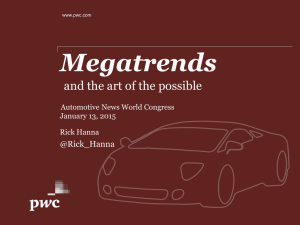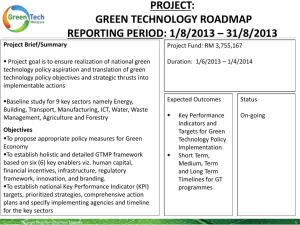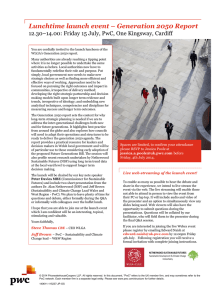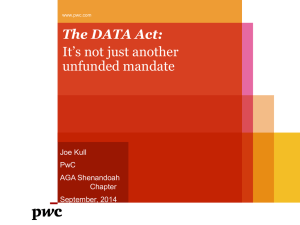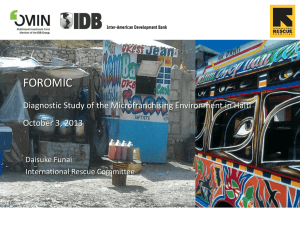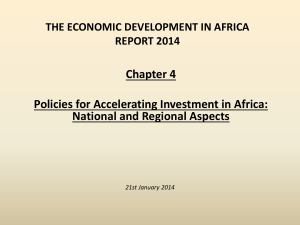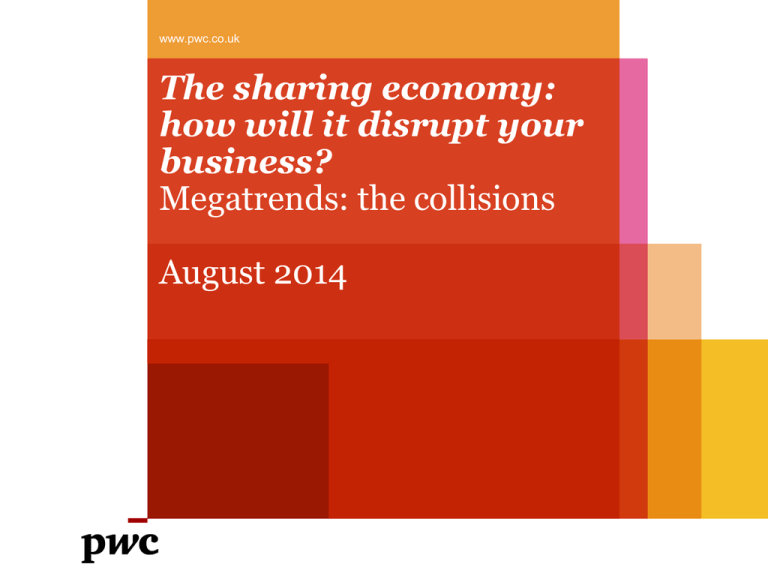
www.pwc.co.uk
The sharing economy:
how will it disrupt your
business?
Megatrends: the collisions
August 2014
The Sharing Economy: Key Messages
1.
The ‘sharing economy’ uses digital platforms to allow customers to have
access to, rather than ownership of, tangible and intangible assets. This
economises on scarce resources and often involves deeper social
interactions than traditional market transactions.
2. Five key sharing sectors (P2P finance, online staffing, P2P
accommodation, car sharing and music/video streaming) have the potential
to increase global revenues from around $15 billion now to around $335
billion by 2025.
3. In the UK, these five sharing sectors could generate revenues of
around £9 billion by 2025.
4. But there are major regulatory and fiscal barriers to overcome to
fulfil this potential and, in scaling up, sharing companies face challenges
in maintaining their uniqueness and authenticity.
5. Incumbents need to see disruption coming from an expansion of sharing
and develop effective strategies to respond, whether by acquisition,
partnership or launching their own sharing services.
PwC
2
Introducing the sharing economy…
• Over the last decade, “sharing” has grown from a means of transaction that took
place between friends and family to the basis of a pool of global businesses
which are increasingly being valued in the billions. From Uber sparking protests
by black cab drivers in London, to AirBnB unsettling hoteliers in New York, it is
also a model which is threatening to disrupt established organisations and ways
of doing business, particularly in “post-materialist”, developed economies.
• We know that many sectors in the economy offer alternatives to ownership. But
“sharing economy” sectors are different because they hold three core features:
(1) Business models are hosted through digital platforms which connect
demand and share capacity dynamically in real-time
(2) Transactions are completed through a variety of methods that offer access
over ownership (e.g. P2P sharing, subscribing, re-selling and swapping)
(3) Consumers are more comfortable with consuming products in a way which
involves deeper social interactions than traditional methods of exchange
• Several high-profile companies have pioneered this new type of business model
and have created vast amounts of value – disrupting traditional competitors in
the process (see right). The megatrends are evolving and colliding together to
drive this value creation:
o The growing number of connected digital devices makes matching
demand and supply easier than ever before.
o Social norms are adapting as consumers become more comfortable
sourcing trust using peer-review systems, which most sharing networks use
to self-regulate quality.
o Resource scarcity is pushing up the cost of ownership.
PwC
3
We estimate that the potential size of the revenue
opportunity in five sharing sectors could be $335bn by 2025
• Beyond these small collection of pioneers, we believe there's a big
opportunity for the sharing economy to play an even more
pronounced role in the commercial landscape.
Sharing economy sectors in the industry life-cycle
Niche
Breakthrough Normalised
Mature
Decline or Rebirth
• We observe that many sectors have progressed along an “S-curve”
pattern where initial low and volatile volumes make way for a
breakthrough company to accelerate growth before the market
saturates. At this point, old sectors mature and decline – to be
replaced by the next overlapping innovation (see top-right).
• We believe traditional industries are in the midst of disruption
from the sharing economy as S-curves for traditional products and
sectors are displaced by the start of a new “Sharing S-curve”.
Illustrative revenue potential for traditional and
sharing economy sectors
2025
• To investigate the scale of the potential revenues at stake, we’ve
projected industry revenues for ten sectors, split between a sharing
economy group (P2P finance, online staffing, P2P
accommodation, car sharing and music and video streaming) and
a traditional sector group (equipment rental, B&B and hostels, car 2013
rental, book rental and DVD rental). We’ve used historical
5%
industry and company revenue data and subject-matter expertise
to place each industry on the S-curve.
• Today, we estimate that the sharing economy group contributes
just $15bn – or 5% of total revenue . By 2025, these same five
sharing economy sectors could make up half of overall
sales with potential revenue of around $335bn. We
estimate that the UK’s slice of this pie could be around £9bn.
95%
Revenue for all ten sectors: US$ 255
billion
Revenue for five sharing economy
sectors: US$15 billion
50% 50%
Traditional
Industry
New 'sharing'
economy
Revenue for all ten sectors: US$ 670
billion
Revenue for five sharing economy
sectors: US$ 335 billion
Source: PwC analysis. Note: Industries in the lifecycle of the Sharing Economy from left to right: Peer-to-peer lending and crowd-funding, online staffing, peer-to-peer accommodation,
car sharing, music and video streaming, equipment rental, Bed&Breakfast and hostels, book rental, car rental, and DVD rental.
PwC
4
However, for the sharing economy to realise this potential,
it will need to overcome significant barriers to growth
• So this trend poses big questions for established businesses
trying to avoid disruption, new entrants looking to scale their
offering and policy makers trying to regulate and manage the
market.
• But there are a range of hurdles for the sharing economy to
overcome before it can realise this potential:
o New regulatory action makes sharing economy
transactions illegal or costly to facilitate
o Governments raise tax burden on sharing economy
transactions
o High-profile events raise significant safety concerns,
triggering a loss of trust in the sector.
o Unanticipated technological disruption (that leapfrogs
sharing economy models)
o As sharing economy platforms scale, they lose
authenticity and differentiation over competitors
o Potential for large-scale acquisitions that reduce
investment and subsequent growth potential
• The decisions that actors make today will decide how far the
sharing economy can overcome these barriers to live up to its
initial hype. We’ve engaged a range of influencers in this
space – from sharing start-ups to established businesses (see
right) – to hear their insights on where the trend is heading –
and what steps they are taking to respond.
PwC
"The sustainable Sharing Economy uses technology to
reshape the world through transforming the need to
own. It's a world in which our collective capability
meets our collective needs, where we collaborate to
enhance each others' lives, protect our planet and
create wealth from which everybody benefits."
Benita Matofska, Chief Sharer, Compare and
Share and global expert on the Sharing
Economy
“We don’t see retailers and manufacturers as
competitors – we want to work with them. Buying new
stuff isn’t going to go away. So this is really about
growing the base by sharing the same ecosystem”
Tom Chapman, CFO, +Swappow, February 2014
“Most retailers missed the first revolution in retail that
digital technology brought: e-commerce. I am
determined not to miss the second one: which I
believe is collaborative consumption. We won’t be just
a retailer in the future – we’ll be an organisation
helping you to improve your home.”
Veronique Laury, CEO of Castorama (part of
the Kingfisher group), May 2014
5
We’ve learned that whatever your organisation looks like
today; the sharing economy is too big an opportunity to
miss out on, or too big a risk not to mitigate
• Organisation’s response to the sharing will depend where they lie in the development cycle – from a disruptive new
entrant to a traditional organisation. For incumbents, the immediate challenge is to avoid being disrupted. Most
sectors have already been touched in some way by the sharing economy; but only a few may see a breakthrough sharing
economy business emerge as a serious competitor. Where a consumption model has prevailed in a sector for many years,
it is often most at risk from disruption. Streaming in the media sector dispelled the myth that ownership and rental
models were the only ways to consume music or films. Retail businesses should assess the potential for sharing models
pioneered by start-ups like Peerby and Bag, Borrow and Steal to do the same in their sector.
• Organisations should also assess the potential for consumers to club together in a peer network to replicate their value
proposition. P2P networks are most likely to emerge where products and services that are widely distributed amongst the
population, involve high fixed costs but low marginal costs and often go under-utilised. The automobile and
accommodation sectors were the first sectors to see peer networks emerge: but this could spread to other sectors who
hold similar characteristics. As energy supply becomes more distributed, customers could start to share excess electricity
to their neighbours. In the communications sector, Fon already allows WiFi customers to share their connection with
others in return for free access to other Fon hotspots around the world.
• Organisations should start the process of identifying the potential for disruption in their sector today. The music, TV –
and more recently the hotels sector – didn’t identify the challenge quickly enough, and value has been displaced whilst
they waited. In contrast, the automobile industry spotted the trend early and got ahead of it: most car manufacturers now
run their own car-sharing schemes; and others have made strategic investments in new entrants – such as Avis in Zipcar
and BMW in parkatmyhouse.
• The next step is to develop a mitigation strategy. The right one will differ across organisations; whether that’s
acquiring a new entrant, partnering or investing in them; or differentiating products to continue to justify the existing
pricing structure. There’s also an opportunity for organisations to develop their own sharing economy concepts: and in
this space, innovation often starts with imitation – for example, using a tried-and-tested approach in one industry in
your own (such as developing “access” options alongside traditional sales channels) – or taking a C2C concept in to a B2C
or B2B environment.
PwC
6
We believe the sharing economy demands a sharing
organisation: one that monetises spare capacity – and
improves business outcomes through sharing intangible assets
• Perhaps one of the most profitable routes for big organisations to
engage in the sharing economy is to assess the potential for sharing
within their own asset base.
• Tangible assets are an obvious place to start. Today’s manufacturing
facilities operate at an average of 20% below capacity but sharing
platforms will allow these to move much closer to maximum efficiency.
In the average office, half of the desks go unused. Most retail premises
are closed for 15 hours. So the sharing economy opens up big
opportunities for cost savings – and new revenue streams.
• Beyond the bricks and mortar, an exciting market is opening up to
facilitate the sharing of intangible assets between businesses. An
organisation’s IP, brainpower and brand, now make up around 80% of
global corporation’s value but in many cases still goes under-utilised.
These assets – which have previously been closed or proprietary – have
suddenly become much more liquid through technology, and the
potential impact of that goes well beyond saving cost. New innovations
are rising at GE after it opened up its patent pool to Quirky, an online
inventor community (see bottom-right).
• Today’s talent demands flexibility and variety from their employers.
Organisations should be considering “sharing” a larger portion of their
talent base, be it with entrepreneurial activity, leisure – or even
another company. Google is leading the field through its high-profile
“20% time” initiative, which motivates employees to forget their job
title and pursue their own business-enhancing ideas for a day a week.
PwC
Examples of innovative B2B sharing models
In 2012, Merck and Medimmune signed an agreement
to share Medimmune’s manufacturing facility. The deal
provided long-term utilisation of excess capacity for
Medimmune; whilst Merck received flexible and rapid
access to capacity for the company’s maturing biologics
pipeline.
Fareshare secures surplus food through its
partnerships with the food industry , including leading
supermarkets, to distribute this to hundreds of local
charities across the UK; reducing waste and helping to
feed thousands of vulnerable people every day
GE partnered with Quirky in 2013 in a $30 million deal
that saw Quirky’s inventor community given open
access to GE’s patents and technology. GE benefits
from Quirky’s ‘playful’ consumer products invention, a
competency which the company previously lacked.
7
In order to scale sustainably, today’s sharing economy
disruptors will need to have a bigger voice in the regulatory
and policy frameworks that are currently emerging
• For new entrants pioneering the sharing economy, the most immediate potential impediment to growth is
regulation. The regulatory flash-points are everywhere. In New York, Airbnb is under investigation by the State
Department for violating tax and health and safety codes. Uber’s presence in London has been referred to the European
Court of Justice, with the company already banned in seven US states alongside European cities like Brussels and Berlin.
• These examples highlight the imperative for sharing economy companies to open a more conducive dialogue with
policy makers and regulators. There is little agreement between the sides arguing whether the growth of the
sharing economy will result in a net benefit or cost on society. But each organisation operating in the sector can take
responsibility for measuring its economic, fiscal, social and environmental impact in its communities in a much more
credible manner. Currently, as few as one in five may be measuring their impact in this way. There are tools available to
do that, including PwC’s market-leading Total Impact Measurement and Management (TIMM) approach.
• Ultimately, we believe sharing economy companies will only be able to scale sustainably by formalising their
business models within the regulatory, legal and tax framework. But this doesn’t mean these frameworks don’t need
to be updated to be fit for a new age. Too often, regulations that are suitable to facilitate and coordinate B2B or B2C
transactions, are not always applicable to the newly created C2C market. And, in general, there is a lack of tailored policy
frameworks for regulating new sharing economy industries.
• The right balance of solutions need to be built from the bottom-up, where local authorities can more quickly trial and
experiment with new models. And its easier to find these solutions when both sides work together – when Airbnb
worked with Amsterdam’s local council earlier this year, they developed a balanced set of rules for residents looking to
rent out their spare rooms, allowing a limit of 2 months a year.
• Organisations born in the sharing economy are endowed with a unique commitment to purpose – their leaders talk
about starting their businesses because they “needed this service to exist in the world”. This passion to make a difference
flows through them to define their whole organisation: BlaBlaCar’s founders talk about their 125-person organisation
“building a new transport network”. As today’s new entrants become as big as the traditional competitors they disrupt,
they must work to keep sight of this differentiating factor – if possible , by codifying it in the values of their organisation
PwC
8
How did we got to our revenue projections? A more detailed
methodology
1. Through a literature review, we identified five prominent sectors in the sharing economy. We then identified a comparator
group of five sectors based on more traditional rental models
New ‘sharing’ sectors: Car sharing; Online Staffing; Streaming (music and video); Crowd-funding and P2P lending and
P2P accommodation
Traditional ‘rental’ sectors: Car rental; Book rental; B&B and Hostels; DVD rental and Equipment rental
2. We collected a historic data series for revenues generated in these sectors by conducting a comprehensive review of existing
market, sector and company sources.
3. We developed our projections based on an "S-curve", a frequent empirical observation of revenue patterns across sectors and
product lines. We have identified 5 stages of growth (see below) and each stage implies different sector growth rates.
4.
We use historical revenue growth data and subject-matter expertise to place each sector’s general position on the curve.
5.
We projected individual sector growth rates using its predicted path on the S-curve, triangulated against reliable existing
sector forecasts (where these are available). We assume each sector is likely to move through roughly two stages of this model
by 2025.
Please note that the projections above form an illustrative projection of the potential of five sharing economy sectors. We describe
several challenges that could see revenue outturns considerably under-shoot this projection. Due to lack of available data on some
sectors and countries, projections are therefore subject to considerable uncertainties. We recommend that our clients look at a
range of alternative scenarios and view the overall total figures as more reliable than individual industry results.
PwC
9
Contacts and services
To find out more about the sharing economy or the megatrends, please contact:
Robert Vaughan
John Hawksworth
Megatrends Project Manager and
Sharing Economy expert
robert.p.vaughan@uk.pwc.com
+44 (0)20 7212 2521
PwC Chief Economist
john.c.hawksworth@uk.pwc.com
+44 (0)20 7213 1650
john.c.hawksworth@uk.pwc.com
For more information on our Economics and Policy services, please visit our website at:
http://www.pwc.co.uk/economics-policy/index.jhtml
This publication has been prepared for general guidance on matters of interest only, and does not constitute professional advice. You should not act upon the
information contained in this publication without obtaining specific professional advice. No representation or warranty (express or implied) is given as to the
accuracy or completeness of the information contained in this publication, and, to the extent permitted by law, PricewaterhouseCoopers LLP, its members,
employees and agents do not accept or assume any liability, responsibility or duty of care for any consequences of you or anyone else acting, or refraining to
act, in reliance on the information contained in this publication or for any decision based on it.
© 2014 PricewaterhouseCoopers LLP. All rights reserved. In this document, "PwC" refers to the UK member firm, and may sometimes refer to the PwC
network. Each member firm is a separate legal entity. Please see www.pwc.com/structure for further details.
PwC
10


